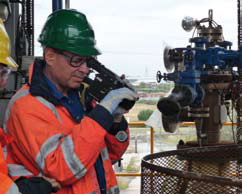
-
Application Stories
• Building
• Furnace and Boiler Tube Inspection
• Medical
BP Site Safety
In the production of acetic acid BP Chemicals is world renowned and responsible for a significant proportion of world capacity. Its proprietary methanol carbonylation technology, Cativa, is in demand globally and in particular in Asia where the company continues to establish new manufacturing partnerships. In the UK its site at Saltend in East Yorkshire is not only a manufacturing flagship but also a major centre for ongoing research and development of the process. Now this facility is turning to the latest FLIR infrared gas leak detection technology to minimise fugitive emissions.
Acetic acid is a highly versatile substance. It is perhaps best known as a major constituent in vinegar and other foodstuffs but is also widely used as a chemical intermediate and solvent in paints, adhesives, textiles, papers and chewing gum. It is produced by the combination of carbon monoxide and methanol in the presence of a catalyst. Every year the company invests many millions of pounds in improving production efficiency, minimising environment impact and protecting the workforce. And it is largely with personnel safety in mind that BP Chemicals is now taking a fresh look at how FLIR thermal imaging can help minimise leaks.
Effective leak detection is of course a site priority at Saltend and one of a number of procedures for ensuring safe operation. As Senior Technologist, Dr. Geoffrey Wilcox confirmed, "We have several established programmes which help us to comply with both regulatory and local requirements." The EU Chemical Agents Directive to protect the health and safety of workers using chemicals and the Control of Major Accident Hazards Regulations, commonly referred to as COMAH, are typical examples. "To support these aims we have many systems for measuring, monitoring and reporting. Some are fixed and some are portable such as personal measurement devices," he continued.
Infrared gas detection is not new to BP Chemicals at Saltend but since last evaluating its potential the technology has been subject to considerable development. FLIR has been a key player in this regard. Thanks to the worldwide demand for its detectors the company has effectively been able to commercialise the technology to the benefit of a wide range of industrial users. The use of infrared to detect gas emissions is one such development.
In 2001 Dr. Geoff Wilcox trialled a highly sophisticated system that used spectral analysis to identify the specific gas emission. "The kit was so unwieldy, it was like welcoming a film crew on site!" he said. One of Geoff's colleagues at BP in Naperville USA, Environmental and Loss Control Specialist Dave Fashimpaur had come to the same conclusion that such a system was not practical for his purposes. Instead he had chosen a FLIR GasFindIR™ HSX thermal imaging camera that was easily portable and designed for real time leak detection rather than non-contact analysis.


Dave Fashimpaur from BP is checking for leaks of natural gas using his GasFindIR HSX
- Home
- |
- Products
- |
- Training
- |
- Application |
- Image Gallery |
- Contact Us
Copyright ©2012 - Thermoscan Co., Ltd. - All Rights Reserved.
Thermoscan Co., Ltd. (บริษัท เทอร์โมสแกน จำกัด)
731 PM Tower, 5th Floor, Asok Dindaeng Road, Dindaeng, Dindaeng, Bangkok 10400
Tel: (02) 642-9489 Fax: (02) 642-9424
E-mail: tms@thermoscan.co.th
